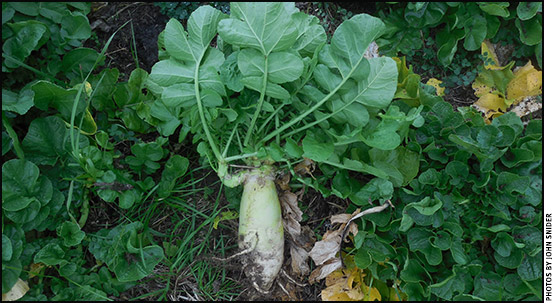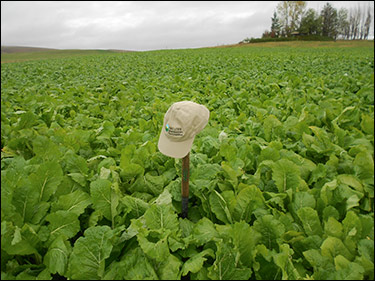
“Graza is the only certified forage radish. It was created by crossing different types of radish from various parts of the world. It grows very fast and can be grazable in 40 days at the proper time of year,” says John Snider.
Forage Brassicas
New varieties are grazable sooner and can be grazed multiple times.
Nontraditional crops can augment forage supplies. Brassicas are a good example. This large family of plants includes turnips, radishes, rutabaga, cabbage, cauliflower, broccoli, rapeseed and canola. Some have been selected/adapted to create varieties that work well as livestock forage.
John Snider (Oregon) works for PGG Seed, a company based in New Zealand that has been producing cultivars that are more flexible and easier to manage for grazing than the traditional bulb turnip.
“There are some taproot varieties that produce a lot of biomass above ground, which can be grazed several times during the year instead of just once,” he explains. “A traditional turnip grows best in cool-season environments and requires 90 to 100 days of good growing weather (but not much heat) for maximum productivity.
“In hotter, drier environments farmers need plants that are more adapted to drought,” he continues. “There are several varieties that are easier to grow than the traditional purple-top turnip and become grazable earlier — at 40 to 60 days,” says Snider.
A challenge with both types is they will flower the following year if they survive the winter.
“We now have new kinds of forage brassicas that can be grazed multiple times,” he says, explaining, if you graze them off before they actually go to seed, they will regrow and produce another stand of forage. You can choose a variety that fits your farm or ranch and the time frame when you need something available to graze.
It all depends on when you want to plant the crop and graze it. You need about the same amount of moisture to start these plants as to start a new crop of alfalfa — either rain or irrigation.
“Turnips require a lot of moisture because they have a big bulb. They all need moisture to germinate and become established, but some of the grazing varieties [can] then get by with as little as 6 inches of in-crop moisture as they are growing,” says Snider.

Hunter Forage Brassica is a proprietary leaf turnip — a cross between a turnip and a Chinese cabbage.
“There are generic varieties of purple-top turnips, and also some proprietary certified varieties, which are produced from foundation seed that has specific purposes for specific climates. For example, Hunter Forage Brassica is a proprietary leaf turnip — a cross between a turnip and a Chinese cabbage. It is bred, produced and marketed by PGG Seed. Another variety is Winfred Forage Brassica, which is a cross between a kale and a turnip,” he explains. It requires less water and is more tolerant of colder weather than the Hunter.
“Graza is the only certified forage radish. It was created by crossing different types of radish from various parts of the world. It grows very fast and can be grazable in 40 days at the proper time of year,” says Snider. All of these new varieties produce more leaf mass and less bulb than a turnip.
“The leaves grow back after grazing. Graza can be grazed multiple times during the growing season. Winfred, Graza and Hunter provide multiple grazing (with regrowth) during the growing season. There are more options today than just traditional turnips. There are also some proprietary purple-top (tankard) turnips that can be used for winter stockpile-type grazing,” says Snider.
“Today radishes and turnips are used for cover crops. There is growing use of a cocktail mix of plants for soil health. These cover crops are also great for grazing. You only get that added value, however, with grazing varieties and not just generic radishes or turnips, because those become quickly unusable after they flower,” he says.

Editor’s Note: Heather Smith Thomas is a freelancer and cattlewoman from Salmon, Idaho.





